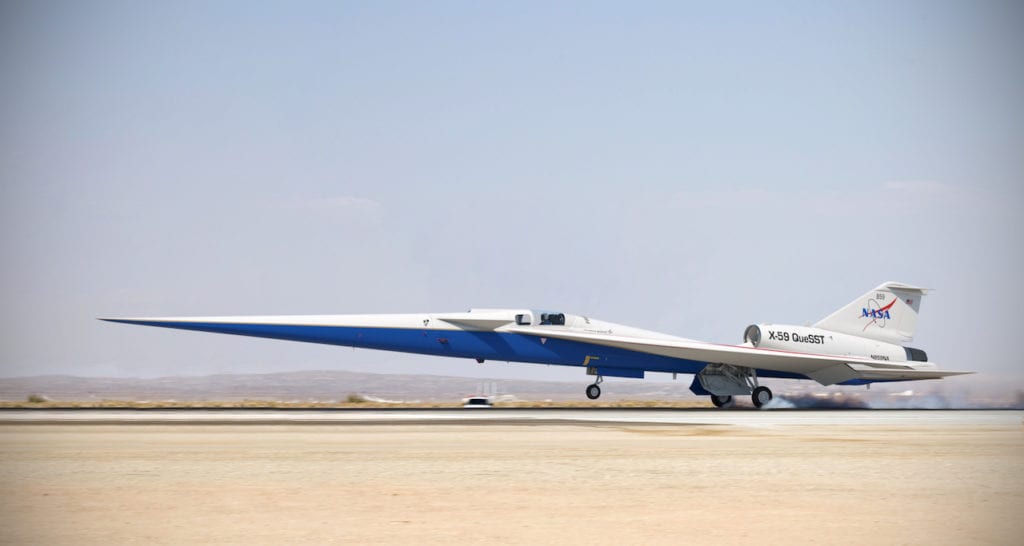
The Federal Aviation Administration (FAA) is moving forward on standards for future supersonic aircraft in announcing rulemaking last week for noise levels for those aircraft. Pictured here is a computer generated illustration of NASA’s X-59 Quiet SuperSonic Technology (QueSST) aircraft landing on a runway. The agency hopes to make the first flight of QueSST next year, in an effort to evaluate how the loudness of a sonic boom and its noise impact could be reduced. Photo: Lockheed Martin
The Federal Aviation Administration (FAA) is moving forward on standards for future supersonic aircraft in announcing a notice of proposed rulemaking last week for noise levels for those aircraft. The proposed rulemaking follows a 2019 FAA proposed rule to update the requirements to apply for a special flight authorization for flying above Mach 1 in the United States.
“This action proposes to add new supersonic airplanes to the applicability of noise certification regulations, and proposes landing and takeoff noise standards for a certain class of new supersonic airplanes,” according to a Notice of Proposed Rulemaking on March 30. “There is renewed interest in the development of supersonic aircraft, and the proposed regulations would facilitate the continued development of airplanes by specifying the noise limits for the designs, providing the means to certificate the airplanes for subsonic operation in the United States.”
The design of avionics systems will have to factor in the cockpit effects of such supersonic flight by including such things as heat dissipation systems. Boom Supersonic is developing its $200 million supersonic airliner, the Overture, and has said that the company’s XB-1 supersonic demonstrator has controls and displays for the environmental control system that keep the cockpit pressurized and cooled and cool other vital aircraft systems in separate bays outside of the cockpit. The outside of XB-1, which is to perform flight tests at Mach 2.2, could reach temperatures above 300-degrees Fahrenheit, Boom said.

Boom Supersonic is putting the finishing touches on its XB-1 supersonic demonstrator. Pictured here is the simulator for the XB-1, which features the same controls as the XB-1 Photo: Boom Supersonic
In addition to Boom, Aerion and Boeing are teamed on development of the 1.4 Mach $120 million AS2 supersonic business jet, which is to begin flight tests in 2024. In February, Aerion said that it had begun concept development for a family of high altitude supercruise aircraft for DoD by using the company’s AS2 experience.
FAA regulations prohibit civil aircraft from operating at speeds exceeding Mach 1 over land in the United States, and the new FAA proposal would not remove that prohibition, but instead establish procedures and noise levels for subsonic operation of those supersonic aircraft during landing and takeoff.
Supersonic commercial air transportation was introduced in the 1970s, and the proposed rulemaking “reflects the many technical advancements in aviation that have occurred since that time,” according to the FAA. “These developments include new noise-reduction technologies such as improved engine designs and materials available for airframe manufacturing.”

Pictured here is a computer generated concept image of Aerion’s AS2, the supersonic business jet that the company hopes will begin flight testing in 2024. In February, Aerion also began initial concept development for the first in a family of rapidly developed high altitude supercruise aircraft for the U.S. Defense market. Photo: Aerion
The only supersonic aircraft that has FAA noise regulations on the books is the European Concorde, which had its last flight in 2003, but the FAA Reauthorization Act of 2018 (P.L. 115-254), says that the agency administrator “shall exercise leadership in the creation of federal and international policies, regulations, and standards relating to the certification and safe and efficient operation of civil supersonic aircraft.” The act also sets a date of Dec. 31 this year, and every subsequent two years, for the FAA administrator to review available aircraft noise and performance data to help determine whether to amend FAA regulations “to permit supersonic flight of civil aircraft over land in the United States.”
The FAA wants to amend noise certification regulations in 14 CFR, parts 21 and 36, to allow new supersonic airplanes, and to add subsonic landing and takeoff (LTO) cycle standards for supersonic airplanes that have a maximum takeoff weight no greater than 150,000 pounds and a maximum operating cruise speed up to Mach 1.8.
The agency said that its proposal is based in part on the Supersonic Transport Concept Airplane (STCA) studies performed by the National Aeronautics and Space Administration (NASA), information provided to the FAA by U.S. industry, and ongoing work by the International Civil Aviation Organization (ICAO) Committee on
Aviation Environmental Protection (CAEP).